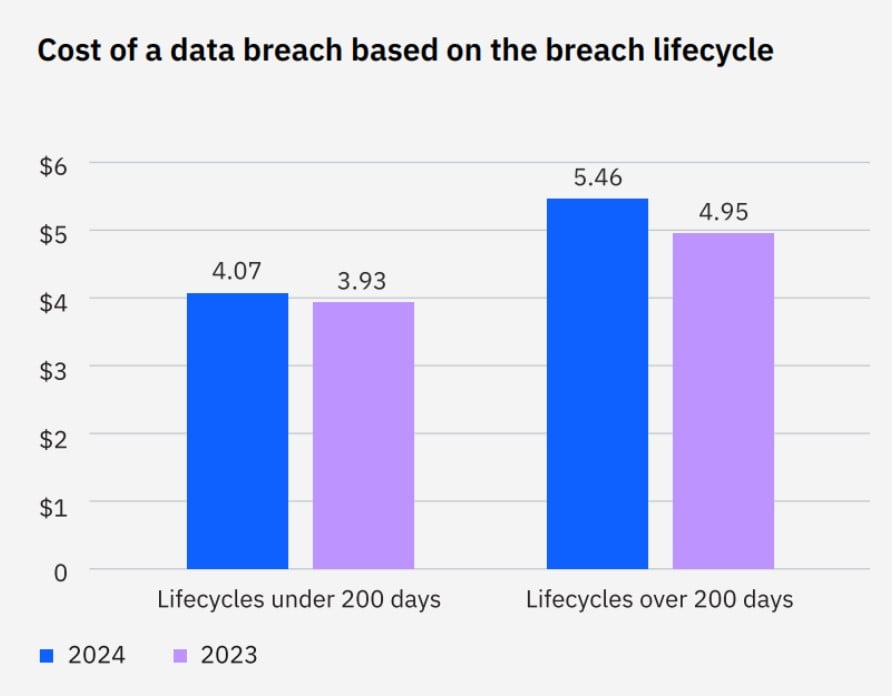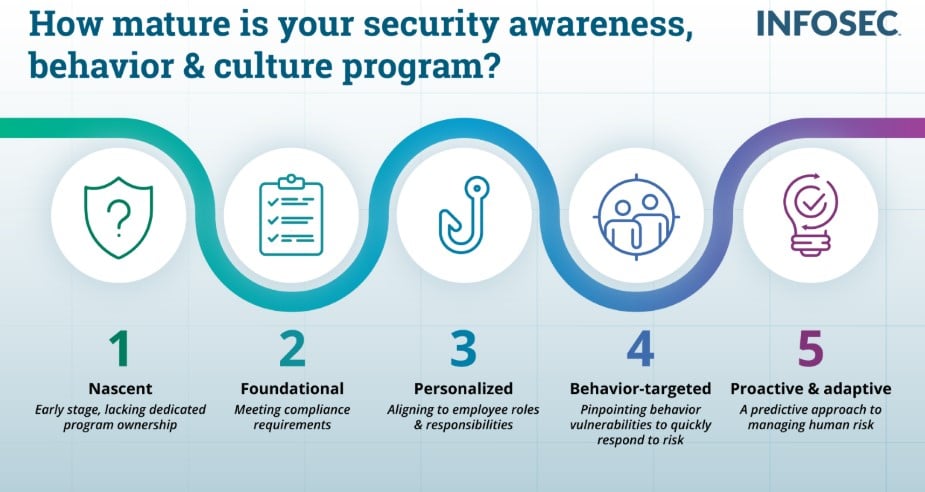Security awareness training in local government: The ultimate guide
Local governments face mounting cybersecurity challenges as they manage sensitive citizen data, critical infrastructure and essential public services. From municipalities and counties to school districts, these organizations have become prime targets for cybercriminals who recognize the value of government data.
The stakes are particularly high for local government employees who regularly handle restricted information — from student records protected under FERPA to sensitive municipal data covered by various privacy regulations. K-12 schools face particular challenges, as they must protect student data and maintain educational continuity while often working with limited cybersecurity resources.
Recent statistics paint a concerning picture. Looking just at ransomware (download our Ransomware paper for more insights):
- 34% of local government IT and cybersecurity leaders reported their organizations were hit by ransomware in 2024
- 54% of those impacted paid a ransom to get some of the data back
- $2.2 million was the average reported ransomware payment
Attackers continue to exploit the human element, with between 68% and 90% of data breaches including some human component, whether through social engineering, credential theft or unintentional errors.
For local governments operating under tight budgets and complex regulatory requirements, building an effective security awareness training program is essential for compliance and protecting vital public services and citizen trust.
What’s in this guide?
This comprehensive guide will walk you through creating and maintaining a security awareness program tailored to local government needs. You'll learn how to:
- Build security awareness that addresses unique public sector challenges
- Meet regulatory requirements while driving real behavior change
- Effectively train diverse staff groups with varying technical skills
- Measure and demonstrate program success
- Transform awareness into lasting cultural change
Read on to learn more, or jump to a specific section:
- Understanding employee behavior in local government
- Benefits of security awareness training
- Elements of a winning program
- Key technology and automation
- Implementing security awareness training
- Measuring security awareness training success
- Shaping the future of local government security
Understanding human behavior in local government

Local government staff handle sensitive citizen data and must balance daily responsibilities with cybersecurity best practices.
Local government employees serve diverse roles — from administrative staff and teachers to public works personnel and emergency responders. Each position carries unique security responsibilities, from protecting citizen data to safeguarding critical infrastructure systems. Without proper training, these daily tasks can expose organizations to significant risks.
"One common misconception is that if you share information and resources with people, they will all process and apply it similarly," explains Keatron Evans, VP of Portfolio Product and AI Strategy at Infosec Institute. "However, everyone's logic varies, and people tend to make decisions subconsciously with the reactive side of the brain instead of the more logical side. This understanding is crucial for developing effective training approaches in government settings."
Phishing simulations & training
![]()
For public servants, security awareness requires shifting from compliance-driven behaviors to genuine engagement. Rather than following security practices because "IT says so," employees must understand their role in protecting citizen data and public trust. This is especially critical in local government, where staff often handle sensitive information protected by regulations like FERPA (for student records), CIPA (for internet safety in schools) and various state-level privacy laws.
Success comes from making security relevant to both work and personal life. When municipal employees see how security practices protect government systems and their digital lives, they're more likely to embrace these behaviors. A teacher who understands how to protect student data at school can apply those same principles to safeguard their personal information at home.
Security awareness isn't about assigning blame or creating fear. It's about empowering public servants with knowledge and confidence to make secure decisions. When staff members understand what to do and why it matters — whether they're processing permit applications, managing student records or maintaining public utility systems — they're more likely to incorporate security best practices into their daily routines.
Benefits of security awareness training
A well-designed security awareness program delivers measurable benefits across multiple dimensions for local governments. Beyond reducing security incidents, it helps organizations meet regulatory requirements, maintain public trust and protect essential services that citizens depend on daily.
The financial case for training is compelling, especially for budget-conscious local governments. Data from the IBM Cost of Data Breach Report 2024 shows that breaches with lifecycles exceeding 200 days cost organizations an average of $5.46 million — $1.39 million more than shorter lifecycles.
 Human-centered attacks take significantly longer to detect and fix, especially when they impact operational technology systems.
Human-centered attacks take significantly longer to detect and fix, especially when they impact operational technology systems.
This cost difference could impact vital public services for local governments operating under strict budgetary constraints. When analyzing breach lifecycles, incidents involving human elements like compromised credentials (292 days) and phishing attacks (261 days) take significantly longer to detect and remediate.
For K-12 schools and local governments, the benefits of security awareness training extend beyond cost savings by helping to address:
- Regulatory compliance: Meet compliance requirements for FERPA, CIPA, PPRA and state-level privacy laws while protecting sensitive student and citizen data.
- Public trust: Demonstrate responsible stewardship of taxpayer resources and citizen information.
- Service continuity: Maintain essential public services by preventing disruptions from cyber incidents.
- Grant eligibility: Meet cybersecurity requirements for federal and state funding opportunities.
- Insurance requirements: Satisfy cyber insurance requirements while potentially reducing premiums.
Most importantly, effective security awareness creates an environment where security becomes part of the organizational culture. When municipal employees understand that security directly impacts both government operations and citizen services, they're more likely to actively participate in risk reduction.
Get six free posters
Reinforce cybersecurity best practices with six eye-catching posters found in our free poster kit from our award-winning series, Work Bytes.
Elements of a winning security awareness program
A successful security awareness program drives measurable behavior change that reduces risk while accounting for the unique challenges of local government organizations. The most effective programs move beyond annual compliance training to create lasting security habits through continuous engagement and reinforcement.

Download our full Security awareness maturity infographic to learn more.
For local governments and schools, content must resonate with diverse employee groups:
- Administrative staff handling citizen records and financial data
- Public works personnel managing infrastructure systems
- Teachers and school staff protecting student information
- Emergency services personnel accessing sensitive data
- IT staff maintaining critical systems
- Part-time and seasonal workers
Role-based training ensures employees receive information relevant to their daily duties. For example, finance staff need focused training on wire transfer fraud and financial system security, while teachers might need additional emphasis on student data privacy and classroom technology security.
Programs should also consider operational realities:
- Limited training time during busy public service schedules
- High turnover rates in certain departments
- Varying levels of technical expertise
- Multiple facility locations
- Mix of office-based and field personnel
- Budget constraints
Successful programs typically progress through these maturity levels:
- Basic Compliance: Annual training and basic policy acknowledgment.
- Active Awareness: Regular training modules and phishing simulations.
- Behavioral Change: Targeted training based on role and risk level.
- Cultural Integration: Security becomes part of daily operations.
- Continuous Improvement: Data-driven program refinement.
Measurement is critical for demonstrating value to leadership and taxpayers. Organizations should monitor both direct metrics like training completion and phishing test results, as well as broader indicators of cultural change like increased security issue reporting and cross-department collaboration on security initiatives.
As programs mature, they should focus on making security accessible and relevant. This means delivering content through familiar channels, making security concepts relatable to government work, and ensuring employees feel supported rather than policed in their security journey.
Key technology and automation to strengthen security awareness
Modern security awareness programs benefit from technologies that streamline delivery while enhancing effectiveness. For local governments and schools, integration capabilities are crucial — connecting security tools with training platforms enables organizations to coordinate responses and deliver targeted education based on real behavioral data.
At the foundation are tools for automating core training functions:
- Phishing training simulation platforms: Test email security awareness while providing actionable feedback. These can be configured to simulate common threats targeting government employees, such as fake procurement requests or impersonated leadership emails.
- Learning management systems: Track training progress across departments while supporting compliance reporting requirements. Look for platforms that integrate with existing municipal or school district systems.
- Reporting dashboards: Monitor program effectiveness and demonstrate ROI to stakeholders, including school boards, city councils and oversight committees.
Consider these implementation factors specific to local government:
Budget-friendly features:
- Multi-year licensing options that align with government funding cycles
- Flexible payment terms that work with public sector budgets
- Shared services options for smaller municipalities
Technical requirements:
- Cloud-based solutions requiring minimal IT resources
- Support for common government security standards
- Integration with existing email and authentication systems
Administrative needs:
- Role-based access control for different departments
- Automated compliance reporting capabilities
- Support for multiple facility locations
The evolution of human risk management takes this integration further by connecting security operation center (SOC) tools directly with training platforms. Real-time alerts and notifications keep security top-of-mind without overwhelming employees. This "just-in-time" approach helps public servants apply security concepts in their daily work while building lasting habits.
See Infosec IQ in action
![]()
Implementing security awareness training that works for your organization
Begin your security awareness journey by assessing your current position. Whether starting from scratch, enhancing an annual compliance program or aiming to become a best-in-class program, your first step is evaluating your organization's needs and capabilities.
Start with a thorough needs assessment:
- Review existing security incident data
- Evaluate current compliance requirements (FERPA, CIPA, state regulations)
- Assess technical capabilities and resources
- Map stakeholder groups and their training needs
- Consider budget cycles and funding sources
Structure your implementation in clear phases:
Assessment Phase
- Establish baseline security metrics
- Document current training practices
- Identify high-risk departments and roles
- Review applicable regulations
Development Phase
- Create role-specific training content
- Design materials for different technical skill levels
- Align content with government policies
- Build assessment tools
Implementation Phase
- Begin with pilot groups
- Roll out department by department
- Provide clear communication and support
- Address technical barriers
Monitoring Phase
- Track completion rates
- Gather employee feedback
- Measure behavior change
- Document compliance
Improvement Phase
- Adjust based on results
- Update for new threats
- Expand program reach
- Enhance engagement
Design your program for sustainability:
- Align training schedules with department workflows
- Account for seasonal staff fluctuations
- Create content relevant to public service roles
- Build support across departments
- Plan for regular updates and refreshers
Secure stakeholder buy-in by demonstrating clear value:
- Show alignment with organizational goals
- Highlight cost savings from prevented incidents
- Connect training to public service mission
- Partner with department leaders
- Document compliance benefits
Consider partnering with established training providers rather than building everything internally. Pre-built, customizable programs can accelerate implementation while ensuring quality and compliance.
Watch our webinar on Building an effective security awareness training program to learn more.
Measuring security awareness training success
Effective measurement combines quantitative metrics with qualitative assessment to demonstrate program value and guide improvements. For local governments, this data helps justify program investments and satisfy oversight requirements while identifying areas for enhancement.
Establish baseline measurements across key performance indicators, then track progress systematically. Training engagement metrics form your foundation — monitor both completion rates and active participation. Look beyond simple completion numbers to assess how employees interact with and retain training material. Employee feedback provides valuable insights into content relevance and effectiveness.
Security behavior changes offer concrete evidence of program impact. Monitor phishing simulation performance and track how employees handle daily security tasks like incident reporting and data management. The quality of security issue reports often reveals more about awareness levels than simple completion statistics.
For local governments, demonstrating program value requires connecting security improvements to operational outcomes. Track metrics like:
- Reduction in security incidents
- Improved response times
- Decreased risk scores
- Enhanced audit readiness
- Strengthened compliance status
These metrics tie directly to broader organizational benefits. When security incidents decrease, IT teams spend less time on incident response and more time on strategic initiatives. Better security practices protect citizen data and maintain public trust. Strong security awareness programs can also help maintain cyber insurance coverage and control premium costs.
Financial impact matters particularly for budget-conscious local governments. Track direct cost savings from prevented incidents and indirect benefits like reduced recovery expenses and optimized resource use. This data helps justify continued program investment to oversight committees and taxpayers.
Maintain regular monitoring and adjust your program based on results. Use measurement data to refine training content, modify delivery methods and target additional support where needed. Security awareness is an ongoing journey requiring continuous assessment and improvement.
Shaping the future of security awareness in local government
As cyber threats evolve, local government security awareness must adapt to meet new challenges. The future lies in building programs that protect not just systems and data, but also the essential public services citizens depend on daily.
Leadership plays a crucial role in cultivating this security-aware culture. Public sector leaders must visibly champion security initiatives and demonstrate their commitment through action. This top-down support and bottom-up engagement from security champions and department leads help embed security awareness into daily operations.
For local governments and K-12 schools, success means:
- Maintaining fresh content that reflects current threats
- Using integrated tools to increase visibility into human risk
- Building collaboration between security, IT and frontline teams
- Creating a culture where security becomes second nature
Need help building your security program just for your local government organization?
- Download a sample two-year training plan to see what other organizations are doing.
- Watch a webinar on building an effective security awareness training program
- Get a free ebook collecting expert tips on security awareness behavior change and culture.






